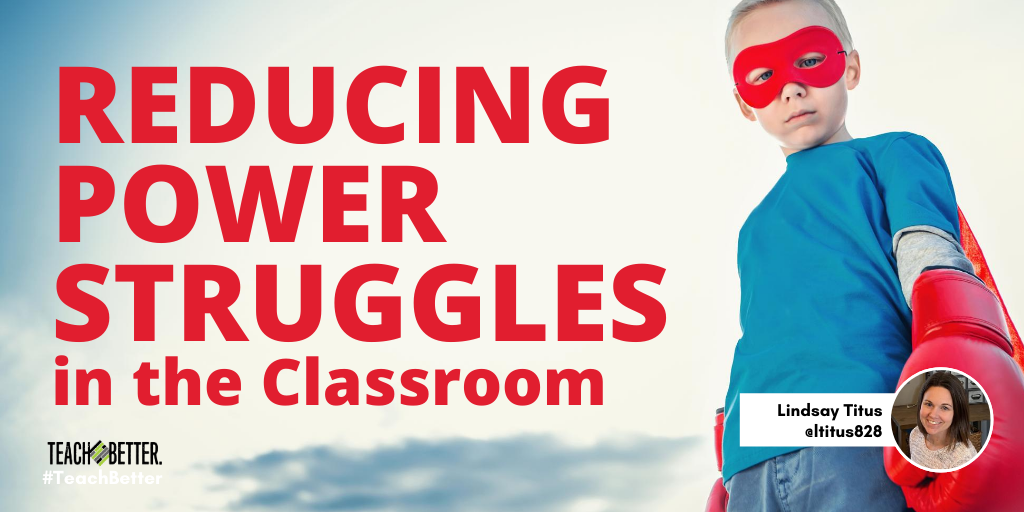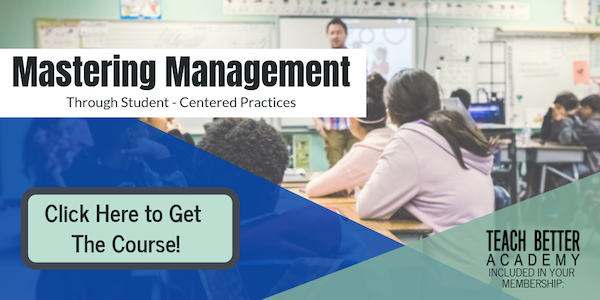TL;DR:
- Prevent power struggles by building relationships, providing choices, beginning with a purpose, checking in with students, and being willing to negotiate.
- If you find yourself entering a power struggle, take a step back, defer the conversation until a time when there isn’t an audience, and walk away.
- If a power struggle does occur, apologize first, then continue to strengthen your relationship with the student each day.
I still remember the first time I really learned about power struggles. It was during my junior year of college in a behavior management course and the professor turned on The Breakfast Club. On the screen appeared the scene of Saturday detention in the library. This scene which is now often referred to as the “eat my shorts” scene, is one of the most frequently used video clips to showcase a power struggle. (If you have not seen the clip, do yourself a favor and go watch it! It is a good one!)
A power struggle is a competition. It is a verbal argument that has one goal: for someone to win. It is a competition of words that most often does not lead to a positive outcome.
In fact, power struggles do more harm than good. They lead to broken relationships, lack of trust, and embarrassment, just to name a few.
The stronger the relationship I have with a student, the more I can hear what they are saying and not focus on how they are saying it. This can help us share our calm when students elevate, instead of rising in frustration with them. Click To TweetCan I prevent power struggles?
The good news is that for educators, there are simple steps we can take to prevent and reduce power struggles from happening in our classrooms.
We are actively trying to reduce tension in the classroom every day. Here are five simple ways to prevent power struggles in your classroom!
Build and strengthen relationships.
The stronger the relationship I have with a student, the more I can hear what they are saying and not focus on how they are saying it. This can help us share our calm when students elevate, instead of rising in frustration with them.
Provide choices.
Providing choices is another great way to reduce a power struggle from happening. Increasing autonomy in the classroom expands student opportunity, which reduces the need for any arguing to occur.
Begin with purpose.
Begin each lesson, day, and activity with the purpose! By sharing the WHY and how specifically the work the students are doing will apply directly to their life today, the less likely they will be to argue it. And yes, I said how it relates today! Often, we want to connect it to the future, but for so many of our students, especially our most challenging, living each day is hard enough. Keep the focus in the present moment!
Check in.
You know that student who loves to argue? The one that you may find yourself saying, “they would make a great lawyer”? Check in with them prior to class! See how they are doing. Take a few minutes to provide attention, gather information, and check in with them to strengthen that connection. Little moments are sometimes the most effective in reducing the likelihood that power struggles happen!
Be willing to negotiate.
Yes, I said it. Negotiate. We do it all the time, yet so often we do not want to admit it. Be willing to compromise. Be willing to budge. Of course, to do this, it relates to teaching with a purpose. We must know the purpose and what the end goal is. We may be aware there is more than one way to achieve a goal or standard, but if we do not know what that goal or standard is, we will be in conflict every time over my way or your way.
What if I react?
We have all been there! If we are aware, we will likely notice when we are in the power struggle. But being truthful, sometimes we do not notice we were in a power struggle until it has happened. Here is my number one strategy: give yourself GRACE! In addition, try these steps out!
- Recognize you are entering into a power struggle! Become aware of how you feel. If your body tenses up, then take a step back (yes, literally) to increase space between yourself and the student.
- Remember that your audience always plays a role in a power struggle. In fact, power struggles do not happen without an audience. Knowing this, remember privacy always prevails! If you are not able to have a private conversation, defer the conversation to a later time.
- Let the student know when you will be able to have a 1:1 conversation with them.
- Walk away! Be okay with not having the last word! Return to instruction and continue nonverbal checks with your student throughout class. At the end of class, thank the student for their patience and remind them of when you will be meeting to hear their side or points of view about the topic that had initiated the power struggle.
Okay, I noticed too late…now what?
The first step after noticing that you have had a power struggle is to apologize. Apologize first. Own your part in the conversation. “I am sorry” comes first from you, without expecting an apology immediately from the student. A student’s ownership of their behavior and the ability to apologize will happen once you have the student’s trust and a relationship. For now, own your part, genuinely apologize, and continue to strengthen the relationship each day.
When it comes to power struggles, awareness is essential. Learning to be aware of when we are entering into one is half the challenge. Increasing our actions from a preventative lens will help, but there still may be times we find ourselves in a power struggle. When this happens, remain calm, take a step back, and breathe.
Keep it simple, keep it focused on the student, and always keep it about building trust, connection, and strengthening your relationship with the student!
About Lindsay Titus
Lindsay Titus is a K-12 Behavior Specialist with a license in behavior analyst. As a Board Certified Behavior Analyst, Lindsay coaches and trains educators on the study of behavior and how to implement evidence based behavior principles in simple and easy ways! With experience as a classroom special education teacher, and behavior specialist in public schools, residential placement, and private settings, Lindsay enjoys working with all educators looking to reignite their passion for education, connect with all students, and conquer challenging behavior in any classroom setting.




